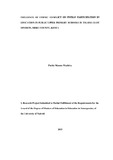| dc.description.abstract | The study sought to investigate the influence of ethnic conflict on pupils’ participation in education in public upper primary schools in Tigania East Division, Meru County, Kenya. Ethnic conflict in Tigania East Division has reduced pupils’ enrollment, retention, attendance and pupils’ participation in primary education. It has reduced access to quality education in the area. The study objectives were: to determine how ethnic conflict affects pupils’ enrollment, retention, teacher - pupil ratio and completion in upper primary public schools, Tigania East Division. The study used a descriptive survey research design. The target population of this study was 27 public primary schools in Tigania East Division with 27 head teachers, 185 teachers and 2700 pupils in class 6, 7 and 8. Teachers and head teachers were selected to participate in the study through purposive sampling technique while pupils were sample through stratified sampling technique. The study had a sample size of 12 head teachers, 36 teachers and 324 pupils. The study primary data was collected by using a questionnaire for teachers and pupils while interview guide was used for head teachers. The research instruments validity was established by availing them to the lecturers in the Department of Education Administration and Planning in the University of Nairobi and peers who established content validity. The reliability of the instruments was established using Cronbach’s Alpha Coefficient after a pilot study. In analysing the quantitative data, the study used descriptive statistics while qualitative data was analysed using content analysis. The study findings indicate that ethnic conflict negatively affected teacher - pupil ratio to a great extent consequently negatively affecting the pupils’ participation in education. The ethnic conflicts significantly contributed to low pupils’ enrollment. The ethnic conflict breed insecurity in the division making schools unsafe for learning and consequently significantly reducing pupils’ enrollment. Ethnic conflicts significantly contributes to low pupils’ retention in education. Pupils’ retention in school was greatly compromised during ethnic conflict as many households’ sources of livelihood were completely destroyed and therefore they could barely financially support their children education. Ethnic conflicts significantly contributes to poor completion rates in education through; high dropout rates, repetition, decreased attendance rates, and wastage. The study recommends that the national and county government should hire more teachers to ensure the TPR is within the recommended range of about 1:40 per school. The management of public primary schools with the support from local administration should conduct regular campaigns to sensitize parents to take their children to schools. The county government and the community leadership should fast track the peace building initiatives to mitigate the occurrence of ethnic conflicts. The schools’ management in collaboration with the ministry of education should formulate a strategy to deal with high dropout rates, repletion decreased attendance rates and wastage rates in their schools. A similar study is recommended on private schools since the present study focussed on public schools. | en_US |

